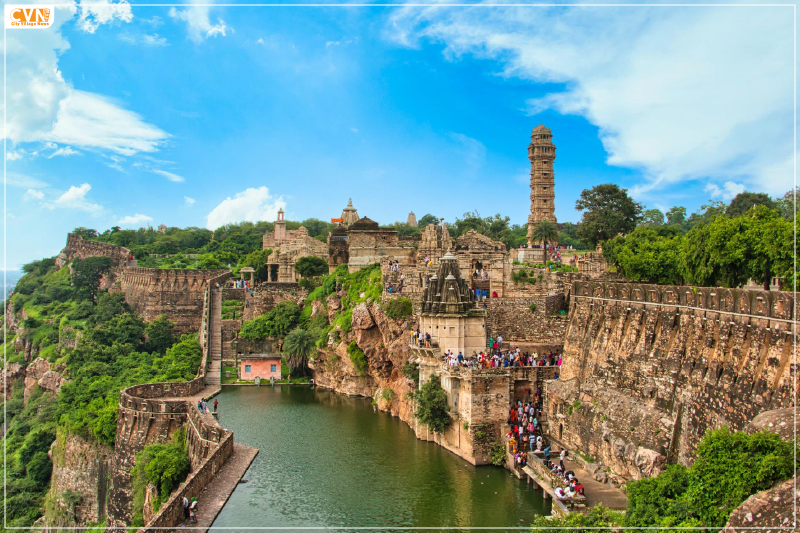Also known as Chittor Fort, the Chittorgarh Fort played a significant role in the pre-colonial history of the Indian subcontinent. Even today, it is on top of the list of must-see historical sites. It is located in the present-day town of Chittorgarh, in the state of Rajasthan. Apart from being historically significant, Chittor is also one of the most famous photography places in India.
Intrigued? Read on to know more about this Rajasthan Fort.
Origin
Many legends and stories surround the origin and construction of the Chittorgarh Fort.
One very famous legend states that it was built by local Mori rulers in the 7th century CE, specifically Chitraganda Mori, after whom it was named. It further goes to say that his descendants expanded it.
Another story relates that it was Bhima, the second Pandava from the epic of Mahabharata, who struck the ground around the region of the fort and, as a result, a large reservoir sprung up. It became an artificial tank named Bhimlat Kund. Several Buddhist stupas from the 9th century were found near here. This story is probably to explain the several water bodies that exist within this fort in Rajasthan.
History
The Chittorgarh Fort in Rajasthan is associated with any tales of bravery, sacrifices, and conquests. This is mostly because of its strategic importance in history. You will soon understand why.
Close to mid-8th century CE, it is said that Buppa Rawal, the Guhila ruler of Mewar, captured this fort; the reason for this is not known. It was then that it became the capital of Mewar. When this happened, the future of the Rajputana kingdom changed—whoever ruled it, practically ruled all of the Rajputana dynasties across present-day Rajasthan, parts of Madhya Pradesh, and Gujarat.
In 1303, Alauddin Khilji, under the Delhi Sultanate ruler, Jalauddin Khilji, waged a battle to lay siege on this fort—a story that inspired later work of the poet-saint, Malik Muhammad Jayasi, “Padmavat”, in the year 1540 CE, and later, the Bollywood film, “Padmaavat”.
After several changes of hands, in the 15th century, the Chittorgarh Fort was seized by Rana Kumbha, the man who brought Mewar to its glory. He built the Victory Pillar or “Vijay Stumbh” to commemorate his victory over them.
The fort finally fell into the hands of Rajput ruler Rana Sanga in the year 1509. He was one of the most powerful rulers of Mewar. Rana Sanga was an opponent on the Indian side when Babur came to the subcontinent from Fergana, in the present-day country of Uzbekistan. He died shortly after his defeat at the latter’s hands.
Finally, in 1567, Emperor Akbar, the grandson of Babur, besieged and managed to capture the Chittorgarh Fort.
Nearly a century later, in 1616, Jahangir, the son of Akbar, signed a treaty with Amar Singh of Mewar, by which the Chittor Fort went back to the Rajputs.
Interesting Facts
- Today, the Chittorgarh Fort is considered to be the largest fort in the Indian subcontinent, covering an area of almost 700 acres and standing royally over a hill at the height of 590 feet.
- In 2013, it made the list of UNESCO World Heritage Sites in a group called the Hill Forts of Rajasthan.
- This fort has 7 gates! – of which, one is the main entrance called Ram Pol. The others are named—Lakshman Pol, Padal Pol, Ganesh Pol, Jorla Pol, Hanuman Pol, Bhairon Pol, and Paidal Pol.
- There are several palaces within this Indian fort which include Padmini Palace, Rana Kumbha Palace, and the Fateh Prakash Palace.
- There are also a few temples that were built within this fort, such as Meera Temple, Kallika Mata Temple, and Meerabai Temple.
- The fort was constructed in such a way that, when seen from above, its layout looks like that of a fish.
- There are also 20 large water bodies here, perhaps enough to supply the entire town and more.
How to Reach
By road, Chittorgarh is easily accessible from any part of the country, since the Golden Quadrilateral passes through it.
By train, Chittorgarh has direct links to major cities in India such as Mumbai, Delhi, Ahmedabad, Ajmer, Udaipur, Jaipur, and Kota.
By air, the airport nearest to Chittorgarh is 70 km away, at the Dabok Airport in Udaipur.

